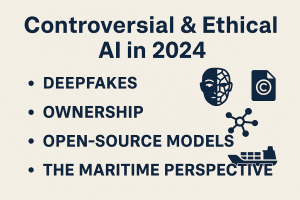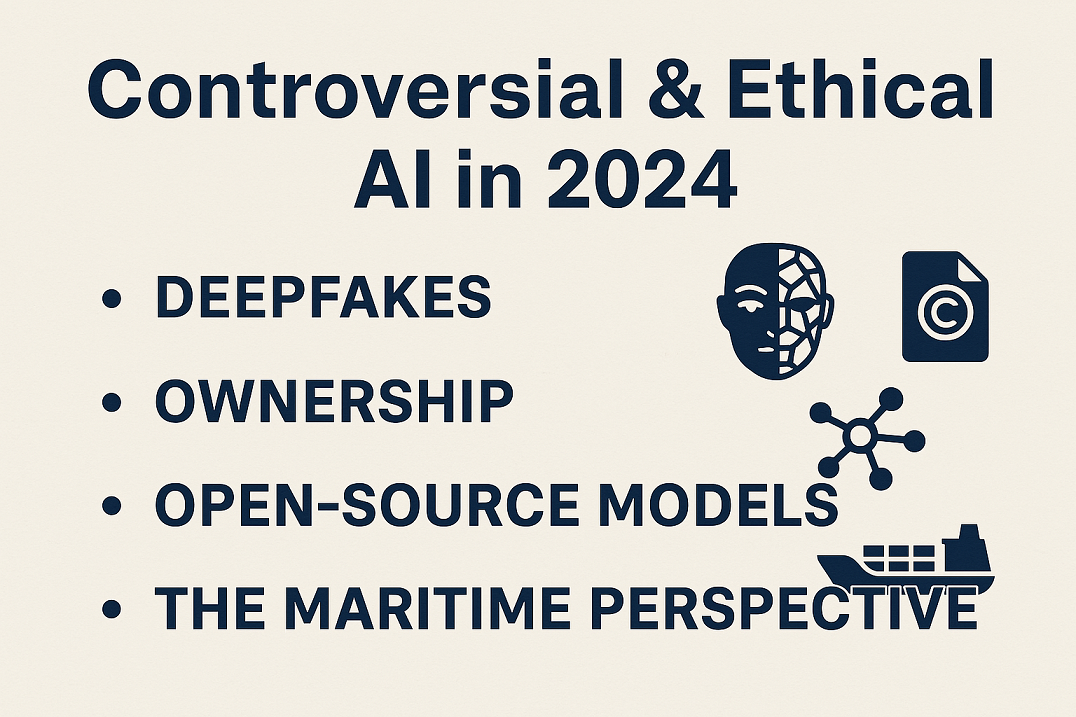Explore trending ethical AI issues in 2024—deepfake scams, artist rights, content ownership, and AI awareness. Learn how AI regulations, open-source tools, and maritime professionals are navigating the risks and benefits.

What happens when artificial intelligence generates images of a ship captain who never existed—or signs a port clearance document automatically?
As AI becomes deeply embedded in our work and lives, especially in global industries like maritime transport, questions about ethics, misuse, and responsibility are no longer theoretical—they are urgent and real.
This article explores the most pressing ethical and controversial topics in AI, including:
-
How to prevent deepfake scams
-
Whether AI is stealing from artists
-
The debate on AI self-awareness
-
Who owns AI-generated content
We’ll also look at trending AI developments in 2024, like AI agents, new search engines, open-source models, and global regulations—with practical insights for maritime students, ship officers, cadets, and shipping companies.
🤖 Key Ethical Issues in Artificial Intelligence
🧟♂️ 1. How to Prevent Deepfake Scams
Deepfakes are synthetic images, videos, or voices created by AI to imitate real people. In 2024, scams using AI-generated voices of CEOs or captains have tricked companies into wire transfers or access breaches.
❗ Risks for the Maritime Sector:
-
Faked port authority instructions
-
Fraudulent crew documents or certifications
-
Voice spoofing of managers or ship owners
✅ Prevention Strategies:
-
Digital Watermarking: Use metadata and AI tools to verify media authenticity
-
Two-Factor Verification: Always confirm high-risk commands via alternate channels
-
Training & Awareness: Cadets and crew should be educated on deepfake indicators
-
AI Detection Tools: Use platforms like Reality Defender, Deepware Scanner, or Sensity.ai
⚓ Maritime Tip: Before responding to audio-only instructions from unknown officials, validate with a trusted contact or cross-check via ship systems.
🎨 2. Is AI Stealing Artists’ Work?
AI models like MidJourney, DALL·E, and Stable Diffusion are trained on millions of public images—often without the consent of artists. This has sparked debate in 2024 over copyright, credit, and creative ownership.
Key Questions:
-
Should AI-generated images credit original styles?
-
Can a designer claim copyright over AI-generated safety posters?
-
What about maritime chart or vessel blueprint reproductions?
Ethical Guidelines Emerging:
-
Opt-out databases for artists (e.g., Spawning project)
-
Platforms now label AI art (e.g., Adobe Firefly complies with content credentials)
-
Maritime content creators should always disclose AI use in visuals and request licenses for adapted works
📚 Example: A maritime instructor using AI-generated SOLAS diagrams for a course should verify if original sources were copyrighted.
🧠 3. Can AI Become Self-Aware?
Self-awareness in AI is a hot philosophical and scientific topic. While AI can mimic conversation and decision-making, no current model is sentient or conscious.
Expert Opinion:
“AI can appear intelligent, but it doesn’t know anything—it’s mimicking patterns, not thinking.” — Dr. Yann LeCun, Chief AI Scientist at Meta
Still, models like GPT-4, Gemini, and Grok-1 display advanced reasoning and adaptability. This raises ethical concerns about transparency, control, and dependency.
Why It Matters in Maritime:
-
Reliance on “smart systems” (like AI navigation tools or auto-pilot assistants) can blur lines between support and decision-making
-
Ensuring human-in-the-loop safety protocols is essential
🧾 4. Who Owns AI-Generated Content?
In 2024, the ownership of AI-generated content is debated in courts and legislation worldwide.
Scenarios:
-
A maritime cadet uses ChatGPT to write a thesis. Is it their work?
-
A shipping company uses AI to generate training videos. Can they copyright it?
Legal Trends:
-
US Copyright Office: Currently doesn’t grant rights to non-human creators
-
EU AI Act: Requires transparency and record-keeping for AI outputs
-
Content Ownership Rule of Thumb: If substantial human input shapes the final result, copyright may be granted
🚢 Takeaway: Always document your input and AI use. Treat AI as a tool, not a creator—this helps defend ownership.
📈 Trending AI Topics in 2024
🔍 AI-Powered Search Engines
You.com, Perplexity.ai, and Microsoft Copilot are reshaping how we find information—offering AI summaries, real-time sources, and multi-modal queries.
📚 Example: A ship officer can now search:
“List IMO sulfur cap compliance rules in table format”—and get it instantly.
🤖 AI Agents & Devices
New smart assistants like Rabbit R1 and Humane AI Pin are AI-powered gadgets designed to replace mobile apps and interact via speech.
-
Use Cases: Maritime voice-activated checklists, instant translations, and emergency protocols
-
Still experimental, but showing potential for hands-free shipboard operation support
💻 Open-Source AI (2024 Highlights)
-
Mistral (France): Lightweight, fast model for local use
-
LLaMA 3 (Meta): Advanced performance with community collaboration
-
Grok-1 (xAI by Elon Musk): Integrated into X platform, real-time search
🌍 Impact: These models empower maritime schools, startups, or NGOs to deploy AI tools without paying large subscription fees.
🧑⚖️ AI Regulation
2024 is the year of AI laws. Major initiatives include:
-
EU AI Act: Enforces transparency, risk classification, and biometric rules
-
US Executive Orders: Focus on safety, labor impact, and export control
-
IMO Interest Growing: Exploring AI ethics for maritime autonomous surface ships (MASS)
FAQs: Controversial AI Topics (2024)
Can AI-generated content be copyrighted?
Generally no—unless there is significant human authorship. Most countries do not allow full copyright for pure AI creations.
How can I detect a deepfake?
Look for inconsistent lighting, lip-sync issues, or unnatural motion. Use detection tools like Deepware, Hive AI, or Microsoft Video Authenticator.
Is it safe to use AI tools in professional maritime training?
Yes, but ensure accuracy, human oversight, and proper sourcing—especially for compliance with STCW, ISM, and SOLAS.
Will AI become sentient?
Current AI has no consciousness, emotions, or awareness—it operates on pattern recognition, not thought or intent.
Conclusion: Staying Ethical and Informed in the Age of AI
As AI becomes more powerful, accessible, and embedded in maritime tools, training, and communication, ethical awareness is essential. From deepfakes to ownership rights and regulatory compliance, today’s maritime professionals must balance innovation with responsibility.
🌊 Next Step: Stay informed. Educate your team. Embrace AI for good—but question it with wisdom.
References & Further Reading
-
“Ethics of Artificial Intelligence,” Stanford Encyclopedia of Philosophy

